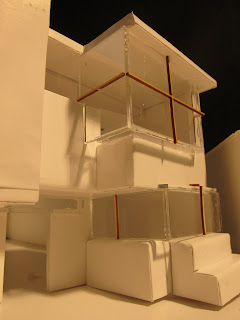
Unfortunately [but really, it's hard to tell what the good news and what the bad news is.], it's just a system. Now that I am sure I can find way to use the system in a manner which I will, in the end, find pleasing/satisfactory, I've moved on to the walls.
I feel like the marrige of the two system will give me a more rich texturing than if I make a final roofing system then make walls to hold it up.
Here are the pictures of the exploration that led me to the roof/light entry system.

The first image is with foam core at 1/2 inch, the holes being about 1.25' at scale.
This second image gives a sense of the light quality. The overlapping boxes give a range of shadows.
Thinking of shadows as negative views of the sky (heavy shadow means a largely obstructed view) one can imagine from this picture that, as one moves beneath this canopy (very literal perspective shifts) the parallax of the grids at different distance will create and destroy spaces as the viewer moves around.
"

 The movement of the body as it crosses though overlapping perspectives formed within spaces is the elemental connection between ourselves and architecture."
The movement of the body as it crosses though overlapping perspectives formed within spaces is the elemental connection between ourselves and architecture."-Steven Holl, from Parallax.
 This is a top down view of the 1/4 inch model.
This is a top down view of the 1/4 inch model.Suggestions included ordering the smaller cubes in a more intentional fashion, aiming for a phenomena rather than mathematics.
Also giving the top grid more depth (6" instead of the 3" I have in this picture).
 This is the view from the altar area, in this scheme. There is less between the viewer and the sky.
This is the view from the altar area, in this scheme. There is less between the viewer and the sky.
Here are the shadows cast by the rotated cubes.
Next for the roof system:
Translucent portions. Clear portions. Unglazed portions. Solid portions.
My aim will be to bring light and space into the chapel. To blend the inside with the outside whatever the weather, but in such a way that each set of circumstances leads to a different melding. I believe I can do this (although I doubt it will be all together successful this first attempt) by having some cubes penetrate the chapel, with their undersides glazed but their tops open, while other will have the opposite treatment. To capture sunlight, there has been talk around the office of filling one of the cubes with a bunch of shiny metal, much like at MIT.
There may also be a solid cube of glass, or one that is made out of may layers of glass, as that one wall.
"As individual element blur, the overall enmeshed experience approaches the strange and transcendent."
-Holl, Parallax
I'm altogether excited.






































